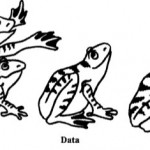Big Data – Science 2.0

Nothing boosts the prospects of page hits on a blog – or funding of a grant proposal – like the phrase “big data.” Why are we enamored with “big data”? It’s not the magic bullet of management or policy: It’s made money for a few companies, but has backfired bigtime in the arenas of national security (NSA surveillance scandals) and social media (Facebook manipulating your emotions without your informed consent; OKCupid doing basically the same thing). Online stores serve you “recommendations” that couldn’t interest you less.
The failures don’t belie the potential of big data; they’re just people failures and symptoms of the immaturity of the field. But that’s the point: As Jon Low says, “Data without context, interpretation and courage is simply a bunch of numbers.” Managers have to provide the context and motive for deep analytics. That will remain true even when “data science” matures. (Or until the Kurzweil/Vinge singularity, whichever comes first!)
At Market Research Corporation of America – my employer in the 1980s – we were proud of having the “world’s largest private database.” It was laughably small by today’s standards. But we learned a lot about what it means to mine what then passed for big data, and the home truths still apply.
Those truths have to do with deciding whether something is true or merely useful, the role of human creativity in posing questions, the speed of analytics versus the speed of decision-making, and the role of theory in data mining.
Here are guidelines for thinking about big data.
Big data: The end of Fisherian hypothesis testing?
Since the agricultural experiments of the early 20th century, scientists have formed hypotheses from empirical observation (or from detecting gaps in theory), and tested the hypotheses on data gathered for that express purpose. That is, humans generated the hypotheses, and the hypotheses were tied up with human meaning and intent. Each hypothesis was tested on an independent data set. This was the classical statistical method, often called Fisherian in deference to R.A. Fisher, its originator.
Sometimes curves were fitted on a subset of the data, with some data points “held out” for a confirmatory test. This foreshadowed some techniques of big data, as we’ll see.
Later in the century, statisticians (notably J.W. Tukey) argued for “exploratory data analysis.” This work leveraged the era’s increased computational power. It meant that empirical hypotheses could be suggested by patterns in a data set rather than from observation of the material-energetic world. Nonetheless, hypotheses were articulated by human analysts, and tested on new data sets, never the same data set. Tukey’s work foreshadowed and inspired the data visualization that is a standard feature of today’s age of big data.
Generating hypotheses automatically
A 1976 paper of mine showed the possibility of machine-generated hypotheses. It was reamed by reviewers, and I had to tone it down in order to get it published. I shared the referees’ revulsion for the idea, but was trying only to show that it was technically possible and had a sound theoretical grounding in Shannon-Kullback information theory.
Why the disgust over machine-generated hypotheses? Campbell (1982) noted the rise of statistical inference followed the then-new notions of thermodynamics and irreversibility, and the later use of these notions in statistical mechanics:
Statistics belongs …to the domain of the organic, to fluctuating life, to Destiny and Incident and not to the worlds of laws and timeless causality … As everyone knows, statistics serves above all to characterize political and economic, that is, historical developments. In the ‘classical’ mechanics of Galileo and Newton there would have been no room for them. And if now, suddenly, the contents of that field are supposed to be understood and understandable only statistically and under the aspect of probability …what does it mean? It means that the object of understanding is ourselves.
Perhaps Campbell overstated the case. Let’s remember, though: The fate of Schrödinger’s cat remains undetermined until a person opens its box.
Theory – DYANA
The data business has small profit margins. To exercise any pricing power, you need to deliver useful analysis and advice to clients.
This was our challenge at MRCA: How to make sense of all that data? We needed a framework for comprehending the data. We found it in the work of marketing scholar Andrew Ehrenberg, who claimed that the negative binomial distribution was the best fit for frequency-of-purchase patterns. Well, whether it was NBD or not, we found we could build a decision support system around software that generated purchase frequency distributions from our data, filtered by demographic and behavioral parameters. We called it DYANA, for dynamic analysis. Quaint, eh?
Knowing how many US households bought an item 0,1, 2, etc. times let us quickly determine average frequency, market penetration, and repeat-buying rates. Drilling down, we could see, for example, how many similar items from manufacturers other than our client were bought by light buyers of our client’s goods. And so on. It worked. Clients loved it.
This led to the insight that theory is a necessary overlay for making sense of big data.
Of course when big data are used for speed and not for knowledge – for example, arbitraging a financial position – it’s a different matter, in fact not science at all. Nobody wants it to ‘make sense’; they just want it to be profitable.
Volume, velocity, and variety.
Today’s big data are characterized by these three Vs. Volumes and volumes of data. Measuring instantaneous changes in markets, metabolisms, and what have you, and delivered to your PC or handheld in milliseconds, from naturally refrigerated server farms in Finland and under the Swiss Alps.
Back in the day, we celebrated DYANA’s ability to deliver results to clients in three days instead of six weeks. We never envisioned millisecond delivery. (As my current métier is technology forecasting, I feel embarrassed to admit this.) The data were stored on reel-to-reel magnetic tapes, as in the photo, with speed limited by the ability of the data librarian to find and mount the right tape.
It was a conventional relational database of ASCII characters. ‘Variety’ in modern big data means a mix of character, photo, drawing, video and sound files. Inconceivable back then!
And yet, it fit the managerial decision cycles of our clients, companies like Coca-Cola, Nabisco, Procter&Gamble, and General Mills. When our competitors began to use supermarket scanners to collect greater masses of data, we didn’t worry because they did not have the skill to process it. Our complacency was misconceived: They soon figured out how to get actionable information out of that mass of data. Our customer base dwindled, as clients adapted their marketing decision making to accommodate more and faster data.
Fishing in the data
Raise a glass to the curiosity of PhD students! They want to answer so many questions, and can afford so little data. As a result, they tend to test too many hypotheses on a single data set. Let’s see why this is risky.
In statistical inference you may reject (or not) a hypothesis at, say, a 90% level. This means (and this meaning is often forgotten) that if you repeat the same experiment on 100 independent random samples of the same size, you will reach the same conclusion about 90 times. You will reach the opposite conclusion about 10 times!
By the same token, if you test multiple hypotheses on the same data set, you increase the chances that you will get a false positive or false negative on at least one of them. This practice is called fishing in the data. The reason for the moniker (which has no connection to Sir Ronald Fisher, so punsters please control yourselves) is that if you test enough ideas on a single data set, you’re likely to get at least one positive result – even if that result is spurious.
This too has implications for big data practitioners. One is that tests should be done either on different large subsets of the big database, or if that is impossible, the acceptance region (significance level) should be tightened for each successive hypothesis that is tested on the entire database.
Another is that money can be made even on “spurious” results.
There is no ‘data science’ – only science.
It’s human nature to get excited when one of the components of scientific progress takes a giant leap, and to focus on it to the exclusion of the others. Understandable, but short-sighted; we should be looking ahead to its implications for the other parts of scientific advance. In 1993 Learner and I wrote:
“Science progresses when any one of its four components – theory, data, methodology and problems – advances by building on the current state of the other three. In a continuing game of leapfrog, any one of the four sectors may experience a breakthrough (at a moment when the others are less active), leaping to the forefront and often spurring support activity and progress among the other three. A new theory may spur researchers to gather data to test it, and the possibility of commercial development [or public good] may make the expense of such data collection worth undertaking…. For instance, the germ theory of disease could not emerge until the microscope (a methodological advance) revealed a new body of previously unobservable data.”
A Leapfrog Model of Scientific Advance
Today, large data sets are made possible by cheaper storage and processing. Storage and processing are methodologies. The data sets give rise to still more methodologies (Python and R languages, new visualization techniques) that may or may not lead to new theories, but in any event are believed to be relevant to problems in marketing, medicine, and environment.
Thus, there is no “data science.” There is only science. Data – and the ways we process it – are just two of its parts. Advances in data (data collection, data definition, data storage, data ontology, etc.) will be followed by advances in analytic methods, new theories (these are already starting to emerge in medicine and scientometrics, to name two areas), the solution of old problems, and the uncovering of new problems. Let’s remember the lesson from the market research firm in the 1980s, and not focus unduly only on the data.
Managerial significance vs. statistical significance
This is a key concept for gaining perspective on big data. To a statistician, the difference between the two kinds of significance lies only in the acceptance region, or “p-value.” Three examples will illustrate.
1. Your data warehouse’s neural net program detects a slightly greater preference for red widgets among buyers in the western part of the country, and for blue widgets in the east. The difference is not statistically significant (at the usual 95% level) and may not be a lasting effect, but it does involve several thousand consumers. At no cost, the neural net triggers another program that routes more red widgets to stores in the west. Revenue is realized that might otherwise have been left on the table. The cost-effectiveness profile of this action means it was managerially significant but not statistically significant. A statistician might insist on at least a 90% test; managerially, a 50% test would justify action.
2. Based on your solid research conclusions, you recommend a certain government action. It is not certain that the desired benefit would exceed the considerable cost, and the program would compete with other worthy government budget priorities. Your research is sound at the 95% level, but the government would, effectively, require a 99.5% level to move this project up the priority list. It is statistically significant but not managerially significant.
3. A 2005 study shows conclusively that the ‘Mediterranean’ diet is superior to the usually prescribed low-fat diet for decreasing blood cholesterol. Food producers, consumers, physicians, pharma companies, and health care payers all have different and possibly conflicting interests in this matter. There is no coordinating mechanism for resolving these conflicts. In other words, the chance that the research will change the way people eat is about nil. The research is statistically significant but not managerially significant at this time.
I did say we can make money from spurious results. To the statistician, ‘spurious’ can mean incorrect. It can also mean not reliable, not replicable. In markets that change in fractions of a second, like securities trading or, to a less extreme extent, example #1 above, any arbitrage opportunity may be ephemeral. That is, it can change so fast that replication is not only impossible but meaningless. This means the p-value argument that opened this section is also meaningless in such a case: We cannot test the opportunity on a hold-out sample.
But go ahead and sell that stock, or ship those red widgets, and do it quick. Put some of the proceeds in the bank, and buy me a beer with the rest.
That particular gap in the market lasted only microseconds. It resulted in no lasting knowledge or general principles, so statisticians have nothing to say about it. But it was useful for us, for a short time.
The singularity
You know the story – the day will come when computers are smarter than people, and we’ll all take orders from machines. I’m going to express an opinion, since we’re on the subject. That is that it won’t be much different from now. People in many occupations already have good, rational, non-embarrassing reasons for doing what a computer says. I’ve written about them here.
Other people, especially in service professions, blindly obey computers even when they shouldn’t. We’ve all had occasion to ask such a person for a perfectly reasonable resolution to our problem, only to hear them tap keys and say, “The system won’t let me do that.” Don’t you want to leap over the counter, grab him/her by the lapels and shout, “I DON’T CARE ABOUT YOUR ‘SYSTEM.’ YOUCAN DO THIS FOR ME.”
Another anticipated feature of the singularity is the convergence of the virtual world and the meat world. This too is here already. Every day I meet people who are aware (and curious) about what’s going on around them, and people who are not. The latter are stuck inside their heads, where they must be processing some kind of model (of whatever level of imperfectness) of the world they live in. That is, they are living in a virtual world of their own devising, without a computer, and yet somehow have managed to keep their bodies alive in the external world.
The singularity will depend on big data. However, I expect no big surprises when it arrives, and no big changes.
Retailer John Wanamaker said, “Half the money I spend on advertising is wasted. The trouble is I don’t know which half.” Countless marketing managers have echoed the sentiment. Big data will eventually ease, if not solve, the problem. Meanwhile, target marketing resembles what someone else said of communism and Christianity: They both sound like good ideas, but no one’s ever been seen actually practicing either of them.
Refs
J. Campbell, Grammatical Man: Information, Entropy, Language, and Life. Simon&Schuster, New York (1982).
L. Delcambre, F. Phillips and M. Weaver, “Knowledge Management: A Re-Assessment and Case.” Knowledge, Technology&Policy, 17:3, 2005.
D.B. Learner and F.Y. Phillips, “Method and Progress in Management Science.” Socio-Economic Planning Sciences, Vol. 27, No. 1, pp. 9-24, 1993.
J. Low, “Despite Disruption, Data and Deadlines, Managers Still Need to Decide.” The Lowdown, July 31, 2014. http://www.thelowdownblog.com/2014/07/despite-disruption-data-and-deadlines.html?utm_source=feedburner&utm_medium=email&utm_campaign=Feed%3A+TheLow-down+%28The+Low-Down%29
S. Noonoo, “Southern Methodist U Debuts Online Grad Program in Data Science.” Campus Technology, 07/31/14. http://campustechnology.com/articles/2014/07/31/southern-methodist-u-debuts-new-online-ms-in-data-science.aspx
F. Phillips, G.M. White and K.E. Haynes, “Extremal Approaches to Estimating Spatial Interaction”. Geographical Analysis, Vol. 8, April, 1976, 185-200.
F. Phillips, “Advanced DSS Design in Consumer and Marketing Research”. DSS’85: Fifth International Conference on Decision Support Systems, 1985. Anthologized in R. Sprague and H. Watson, eds., Decision Support Systems: Putting Theory into Practice. Prentice-Hall, 1986.
This article:



